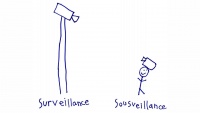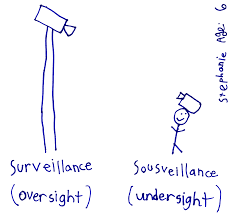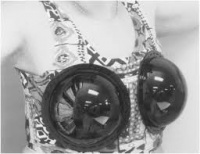Sousveillance
The term Sousveillance, coined by computational photographer Steve Mann, occurs when a participant of an activity records the activity -- typically by way of a small, wearable camera. The term is derived from the French word “sous” meaning below, which contrasts the typical meaning of the word surveillance, derived from the word “sur”, meaning above. As such, surveillance refers to a sort of ever-watching camera high above those participating in an activity, but sousveillance entails moving the camera downwards - to eye-level, or human-level. This practice has been fueled by the emergence of small surveillance technologies, and the public's frustration surrounding surveillance by authorities. Sousveillance provides individuals with an increased sense of power and attempts to counter previous surveillance bias. Similarly, Inverse surveillance is a particular type of sousveillance in which those who are usually surveilled do the watching, recording, and analyzing as a way to study and verify the authenticity of the surveillance methods being used on them.
Contents
History
Steve Mann is a Canadian technology researcher and a strong advocate for privacy rights. His paper, Sousveillance: Inventing and Using Wearable Computing Devices or Data Collection in Surveillance Environments, begins with one of the motivations to his origination of the term, Sousveillance; the September 11, 2001 attacks. Highlighting this is the fact that security experts and privacy advocates say there has been "a surge in the number of video cameras installed around the country[U.S.]" since the attacks. Anti-surveillance activists have claimed that there was a 40% increase in new cameras in New York's financial district between September 2001 and 2002.[1] Together with Professor Ian Kerr, Mann has written extensively on surveillance and developed the concept of sousveillance. Mann believes that sousveillance will make it easier for people to access and collect data about their own surveillance and attempt to counter it.[2] Sousveillance redistributes the power that, historically, had only belonged to authority figures. In the past “security operate[d] by tracking everything that move[d] (Lyon),”[3] and while this still exists in the era of sousveillance, subjects of surveillance are now able to do their own surveilling. Those who practice sousveillance exercise their own democratic rights because they are taking the power back into their own hands. Common examples of sousveillance devices are cell phone cameras, body cams, and heart monitoring devices, which people use to document their experiences from their own personal perspective.
Creating A Watching Culture
In Mann’s ideal world, everyone would be recording their actions at all times which in turn would deter crime and create a safer environment for all citizens. The practice of all citizens watching and recording one another would allow for citizen's to self-police themselves. After an adjustment period where individuals would becoming more comfortable with constantly being watched, crime would diminish. This idea, however, does not sit well with many because it creates a citizen version of a police state.
In actuality, the most common form of sousveillance is done by citizens collecting information in the form of pictures and videos in areas where power is abused and crime is ignored. Sousveillence offers citizens a way to shed light on abuses of power while calling for a more transparent government and legal process. Essentially, it allows individuals to take justice into their own hands and can initiate serious consequences to those that abuse power or participate in wrong-doings. This often shows up in situations of police brutality. Although at the time a bystander might not be able to interfere in a case of police brutality, the act of recording allows light to be shed on the situation. Sharing these videos can cause an uproar in the community and actions can be taken to prevent the entire situation from happening in the future. Similarly, in repressive nations, sousveillance can leak troublesome news to the outside world, and be used during protesting or uprisings.
Types of Sousveillance
Camera Sousveillance and Coveillance
In the most traditional sense, surveillance entails watching by means of a camera or video recorder. Because of this, inverse surveillance is exercised in the same fashion, in which the subjects of surveillance are empowered. Sousveillance originated with cell phone cameras and has significantly evolved as a practice since. Most people carry a cell phone on them at all times, which gives individuals the ability to record their surroundings at any given moment. Sousveillance transformed the surveilling society into a constant watch party. Mann said, “we now live in a society in which we have both the few watching the many and the many watching the few.” Mann delineates the many watching the many, in a phenomenon called coveillance, where one citizen watches another. The dynamics at play in coveillance involve the "conditions of interactions" among citizens being photographed or otherwise, in which they would not object to being recorded, given the fact that they can see the image and the image capture device in the context of a performance space. These conditions are opposite to the conditions that organizations hold, when observing customers engaged in Sousveillance, or coveillance in their establishments. Camera Sousveillance will be met as a "social act of challenging their authority" rather than mere existence of Sousveillance. Coveillance, in this case, can be a way to overcome the objections that surveillers may have. However, this can only be the case with high-level coveillance, where rather than low-level coveillance, including customers who engage in customer-customer coveillance, the coveillance would be accepted only in the case of corporation-corporation coveillance, in which two corporations are monitoring another large corporation.
Heart Monitoring Sousveillance
Typically, surveillance is associated with watching with the eyes, but new monitoring methods are emerging.
Fitbits may be considered sousveillance technology as participants of physical activity track their own heart rate, calories, and fat burning. Instead of having doctors periodically monitoring their patients' health, individuals are able to monitor their own health on a day-to-day basis. Traditionally, EKG’s are taken once and patients only have one timestamped piece of information regarding their heart health. The independent monitoring through a personal device now allows individual patients to store and process information regarding their own health.
The Holter Heart Monitor is a small device that can watch cardiac actions for 24 - 48 hours. This device can add additional tracks to an audiovisual cyborglog, which can benefit personal safety.[4]
Personal Sousveillance
Personal sousveillance is “bringing cameras from the lamp posts and ceilings down to eye-level, for human-centered recording of personal experience" (Mann); it helps build a community, unlike surveillance, which tends to tear communities apart. Due to the increasing availability of wearable technology, this is becoming more and more accessible.
During a phone call, if one of the parties involved records the phone call, that is considered sousveillance. If the phone call is being recorded by someone outside of the conversation, that is surveillance. One ethical issue that arises is that the other person in the conversation may have no idea they are being recorded. Similarly, a person filming their own experience in a public place can make the other inhabitants of that space uncomfortable, or worse, if the other parties are unaware and don't consent to the surveillance. This could occur via GoPro, Google Glass, or other personal wearable cameras.
A GoPro is a small, compact camera used for taking pictures and recording from a person's point of a view. The cameras can be attached to a holster on the body, a helmet, a video stick, or even a surfboard or skateboard. These devices have become extremely popular to extreme athletes and adventurers who want to show others their experiences, or for vloggers that have a following online.[5]
Released in 2013, Google Glass is a model of eyeglasses with smart technology. This voice-controlled device allows users to retrieve relevant information, such as flight status, directly in their field of vision. The product failed on the market, proving to be too hard to integrate into everyday life. Google Glass has made a recent comeback by helping autistic children recognize and respond to emotion. The glasses translate facial expressions into emojis, making it easier for these children to read emotion. [6]
Sousveillance in Art
Steve Mann created several sousveillance devices, each for a different purpose.
In 2001 Mann created a HeartCam, a bra that has a camera embedded inside to revert the male gaze. The HeartCam counts how many times someone looks at the wearer's breasts. Since the camera is placed on the chest it is clear how many eyes are in the wrong place. In a philanthropic act, Nestle released a similar device in order to raise awareness for breast cancer. Besides helping document acts of objectification, sousveillance can also be used to help raise awareness for important causes in society.
Mann also created a self-defense suit called the Aposematic Suit which possesses an invisibility feature that is reflective, acting as a two-sided video mirror. This is intended to protect the wearer from predators because a potential attacker will see themselves rather than a victim. This mode is activated as someone moves in to close proximity of the suit. “Souveillant technology takes the typical surveillance technology a step further by placing an individual in control of how they will be seen, if at all.”[7] These developing technologies may protect one's privacy and or help maintain one's anonymity, in an age when the two are so rare.
Sousveillance as an Alibi
Alibi Sousveillance is the practice of using sousveillance as evidence to prove innocence from any sort of accusation of wrong-doing. An example of this is when people place cameras on their dashboard in order to record road-rage and accidents. Another example of this is police wearing body cameras or attaching dash cameras to their vehicles in order to monitor the events. A study conducted in California shows that the act of police recording events has prevented unnecessary use-of-force by 59% and reports of complaints against police officers fell by 87%.[8] On Aug. 12, 2003, a man was convicted for the murder of a woman. He and his lawyer insisted that he had an alibi as he was at a Dodgers game at the time of the murder. However, when they looked through the surveillance tapes they were unable to find conclusive evidence. It also happened that the show Curb your Enthusiasm was filming in Dodgers stadium and it just happened that in one of their tapes he was clearly visible as having been there. Upon this, the man was exonerated and saved from death row.[9] It was sousveillance rather than surveillance that actually saved this man's life.
Ethical Issues
Countering Bias Surveillance

In the past, video surveillance has been extremely biased. The observation process has involved many discriminatory observations, leading to biased conclusions.[11] Sousveillance has brought to light many of these issues and sparked action. Police departments have implemented police body cams, an instance of sousveillance, as an attempt to prevent biased arrests. This works because people who know they are being watched are often deterred from doing things they would otherwise do in private, which allows officers to survey their actions on their own. In a more formal sense, body cameras can be used for Alibi Sousveillance. Because of the recent Michael Brown case, and other similar incidents, there has been a strong call for police officers to wear body cams while on duty. This helps the police officers, and law enforcement as a whole, gather hours of evidence in an attempt to create a more lawful society. Moreover, it helps facilitate fairer treatment towards citizens, as it adds an increased sense of accountability with respect to the officer. As of February 2019, every police officer in New York City has been issued a body camera.[12] According to Police Commissioner James O’Neill “Body-worn cameras enhance the safety and accountability of the dedicated men and women of the NYPD.”[12] In the Eric Garner case in 2014, the subject's friend used sousveillance tactics to capture the whole incident on video. Evidence was not only provided from the police officer's point of view but also from a bystander's as well. Multiple perspectives helped to provide a better understanding as to what happened to Eric Garner. In 2015 when Walter Scott was shot in North Carolina, the circumstances of the murder would not have been revealed if not for a local sousveiller. The video revealed the events of the officer shooting Scott and planting the murder weapon on his body.[13]
Luciano Floridi argues that "the right of privacy is a right to personal immunity from unknown, undesired, or unintentional changes to one's own identity as an informational entity." [14] If everyone is both watching and being watched, all the time, we no longer have this right since our privacy is often compromised in public spaces. As a result of personal sousveillance devices, our personal privacy can be violated at any given time or place. In a world with little to no online privacy, constant surveillance and sousveillance eliminate the last private space we have: the physical world. The emergence of sousveillance and the information and evidence it has brought to society in the 21st century is beginning to change the biased lens of surveillance. Surveillance provides a one-sided view of subjects which creates strong biases, but bringing the cameras down to eye-level has begun to counter some of these biases.[15]
Privacy
While sousveillance has prompted positive ethical implications, like countering bias arrests or providing the average citizen with more power, it is clear that there are major privacy concerns. A study in the Rotterdam city center found that people actually prefer surveillance cameras to many small sousveillance cameras held in hand by other people in their surroundings. One reason is that surveillance cameras have been around longer and surveillance is usually done by authorities. Another reason is that some people might think, compared to authorities, people on the street are more likely to use the recordings for crimes like stalking and harassment.[16]
Upskirting
One ethically dubious violation of privacy that has increased with the onset of sousveillance devices is upskirting. Upskirting "involves the use of video cameras in public spaces to record underneath women’s clothing".[17] Video voyeurism, including upskirting, is understudied in general, and legal punishments for upskirting vary by state.
The advent of the information revolution saw legal systems ill-equipped to deal with this new violation of privacy. The main challenge arises from "how states define intimate areas and whether those areas are protected in public spaces."[17] However, despite the fact that "no perfect legal definition for video voyeurism exists," state laws have become more harsh towards upskirting and related crimes, shifting the legal perspective from simply a crime against society to one against individuals and their autonomy.[17]
See also
References
- ↑ Mann, Steve; Nolan, Jason; Wellman, Barry (September 2002). "Sousveillance: Inventing and Using wearable Computing Devices or Data Collection in Surveillance Environments" Surveillance and Society. 1(3): 331-335. Retrieved April 28, 2019.
- ↑ Light, Jana. "Sousveillance". Reset.org. Retrieved April 28, 2019.
- ↑ Lyon, David (2012). "Introduction". Liquid Surveillance: A Conversation.
- ↑ Mann, Steve (January 2004). "Sousveillance: Inverse Surveillance in Multimedia Imaging". Proceedings of the 12th ACM International Conference on Multimedia. New York.
- ↑ Pandian, Ananth (2017). "What is a GoPro, and what can it do?" Digital Trends. Retrieved April 28, 2019.
- ↑ "Remember Google Glass? Now It’s Helping Kids With Autism Recognize Emotions". Relevant Magazine. April 11, 2019. Retrieved April 28, 2019.
- ↑ Spaces of Surveillance: States and Selves- Susan Flynn 2017
- ↑ [https://www.cam.ac.uk/research/news/first-scientific-report-shows-police-body-worn-cameras-can-prevent-unacceptable-use-of-force "First Scientific Report shows Police Body-Worn-Cameras Can Prevent Unacceptable Use-of-Force". 23 December, 2014. University of Cambridge.
- ↑ Fleming, Kirsten (September 23, 2017). "How 'Curb Your Enthusiasm' saved this man from prison". Retrieved April 28, 2019.
- ↑ ["https://securitydii.com/sousveillance-policing-digital-world Sousveillance impact on policing in a digital world"]. 16 Aug 2017. Security DI.
- ↑ Observing bodies. Camera surveillance and the significance of the body, Lynsey Dubbeld.
- ↑ 12.0 12.1 "Body-worn Cameras". NYPD.
- ↑ "Surveillance of digital life and the use of sousveillance as a response" Sam Shepherd 10/19/2015 https://medium.com/@sam.shepherd/surveillance-of-digital-life-and-the-use-of-sousveillance-as-a-response-7b306cfdb6e8
- ↑ Informational Friction Luciano Floridi 2014.
- ↑ "Why We Must Continue to Turn the Camera on Police" Ethan Zuckerman July 11, 2016 https://www.technologyreview.com/s/601878/why-we-must-continue-to-turn-the-camera-on-police/
- ↑ "Sousveillance and its impact on privacy" Nicolas Lerch June 2014 https://www.researchgate.net/publication/273574057_Sousveillance_and_its_impact_on_privacy
- ↑ 17.0 17.1 17.2 McCann, W., Pedneault, A., Stohr, M. K., & Hemmens, C. (2018). Upskirting: A Statutory Analysis of Legislative Responses to Video Voyeurism 10 Years Down the Road. Criminal Justice Review, 43(4), 399–418. https://doi.org/10.1177/0734016817741342
| ←Back • ↑Top of Page |

